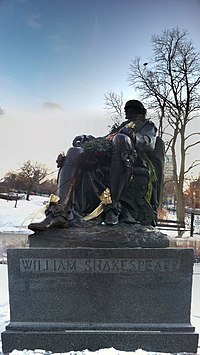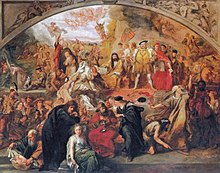cultură şi spiritualitate
Influence

Shakespeare's work has made a lasting impression on later theatre and literature. In particular, he expanded the dramatic potential of characterisation, plot, language, and genre.[157] Until Romeo and Juliet, for example, romance had not been viewed as a worthy topic for tragedy.[158] Soliloquies had been used mainly to convey information about characters or events; but Shakespeare used them to explore characters' minds.[159] His work heavily influenced later poetry. The Romantic poets attempted to revive Shakespearean verse drama, though with little success. Critic George Steiner described all English verse dramas from Coleridge to Tennyson as "feeble variations on Shakespearean themes."[160]
Shakespeare influenced novelists such as Thomas Hardy, William Faulkner, and Charles Dickens. The American novelistHerman Melville's soliloquies owe much to Shakespeare; his Captain Ahab in Moby-Dick is a classic tragic hero, inspired byKing Lear.[161] Scholars have identified 20,000 pieces of music linked to Shakespeare's works. These include two operas byGiuseppe Verdi, Otello and Falstaff, whose critical standing compares with that of the source plays.[162] Shakespeare has also inspired many painters, including the Romantics and the Pre-Raphaelites. The Swiss Romantic artist Henry Fuseli, a friend of William Blake, even translated Macbeth into German.[163] The psychoanalyst Sigmund Freud drew on Shakespearean psychology, in particular that of Hamlet, for his theories of human nature.[164]
In Shakespeare's day, English grammar, spelling and pronunciation were less standardised than they are now,[165] and his use of language helped shape modern English.[166] Samuel Johnson quoted him more often than any other author in his A Dictionary of the English Language, the first serious work of its type.[167] Expressions such as "with bated breath" (Merchant of Venice) and "a foregone conclusion" (Othello) have found their way into everyday English speech.[168]
Critical reputation
"He was not of an age, but for all time."
Shakespeare was not revered in his lifetime, but he received a large amount of praise.[170] In 1598, the cleric and authorFrancis Meres singled him out from a group of English writers as "the most excellent" in both comedy and tragedy.[171] The authors of the Parnassus plays at St John's College, Cambridge numbered him with Chaucer, Gower and Spenser.[172] In theFirst Folio, Ben Jonson called Shakespeare the "Soul of the age, the applause, delight, the wonder of our stage", though he had remarked elsewhere that "Shakespeare wanted art".

Between the Restoration of the monarchy in 1660 and the end of the 17th century, classical ideas were in vogue. As a result, critics of the time mostly rated Shakespeare below John Fletcher and Ben Jonson.[173] Thomas Rymer, for example, condemned Shakespeare for mixing the comic with the tragic. Nevertheless, poet and critic John Dryden rated Shakespeare highly, saying of Jonson, "I admire him, but I love Shakespeare".[174] For several decades, Rymer's view held sway; but during the 18th century, critics began to respond to Shakespeare on his own terms and acclaim what they termed his natural genius. A series of scholarly editions of his work, notably those of Samuel Johnson in 1765 and Edmond Malone in 1790, added to his growing reputation.[175] By 1800, he was firmly enshrined as the national poet.[176] In the 18th and 19th centuries, his reputation also spread abroad. Among those who championed him were the writers Voltaire, Goethe, Stendhal and Victor Hugo.[177]
During the Romantic era, Shakespeare was praised by the poet and literary philosopher Samuel Taylor Coleridge; and the criticAugust Wilhelm Schlegel translated his plays in the spirit of German Romanticism.[178] In the 19th century, critical admiration for Shakespeare's genius often bordered on adulation.[179] "That King Shakespeare," the essayist Thomas Carlyle wrote in 1840, "does not he shine, in crowned sovereignty, over us all, as the noblest, gentlest, yet strongest of rallying signs; indestructible".[180] The Victorians produced his plays as lavish spectacles on a grand scale.[181] The playwright and criticGeorge Bernard Shaw mocked the cult of Shakespeare worship as "bardolatry", claiming that the new naturalism of Ibsen'splays had made Shakespeare obsolete.[182]
The modernist revolution in the arts during the early 20th century, far from discarding Shakespeare, eagerly enlisted his work in the service of the avant-garde. The Expressionists in Germany and the Futurists in Moscow mounted productions of his plays. Marxist playwright and director Bertolt Brecht devised an epic theatre under the influence of Shakespeare. The poet and criticT.S. Eliot argued against Shaw that Shakespeare's "primitiveness" in fact made him truly modern.[183] Eliot, along with G. Wilson Knight and the school of New Criticism, led a movement towards a closer reading of Shakespeare's imagery. In the 1950s, a wave of new critical approaches replaced modernism and paved the way for "post-modern" studies of Shakespeare.[184] By the 1980s, Shakespeare studies were open to movements such as structuralism, feminism, New Historicism, African-American studies, and queer studies.[185][186] In a comprehensive reading of Shakespeare's works and comparing Shakespeare literary accomplishments to accomplishments among leading figures in philosophy and theology as well, Harold Bloom has commented that, "Shakespeare was larger than Plato and than St. Augustine. Heencloses us, because we see with his fundamental perceptions."[187]
Speculation about Shakespeare
Authorship
Around 230 years after Shakespeare's death, doubts began to be expressed about the authorship of the works attributed to him.[188] Proposed alternative candidates include Francis Bacon, Christopher Marlowe, and Edward de Vere, 17th Earl of Oxford.[189] Several "group theories" have also been proposed.[190] Only a small minority of academics believe there is reason to question the traditional attribution,[191] but interest in the subject, particularly the Oxfordian theory of Shakespeare authorship, continues into the 21st century.[192]
Religion
Some scholars claim that members of Shakespeare's family were Catholics, at a time when Catholic practice was against the law.[193] Shakespeare's mother, Mary Arden, certainly came from a pious Catholic family. The strongest evidence might be a Catholic statement of faith signed by John Shakespeare, found in 1757 in the rafters of his former house in Henley Street. The document is now lost, however, and scholars differ as to its authenticity.[194] In 1591 the authorities reported that John Shakespeare had missed church "for fear of process for debt", a common Catholic excuse.[195] In 1606 the name of William's daughter Susanna appears on a list of those who failed to attend Easter communion in Stratford.[195] As several scholars have noted, whatever his private views, Shakespeare "conformed to the official state religion", as Park Honan put it.[196][197] Shakespeare's will uses a Protestant formula and he was a confirmed member of the Church of England, where he got married, his children were baptized, and where he was buried. Other authors argue that there is a lack of evidence about Shakespeare's religious beliefs. Scholars find evidence both for and against Shakespeare's Catholicism, Protestantism, or lack of belief in his plays, but the truth may be impossible to prove.[198]
Sexuality
Few details of Shakespeare's sexuality are known. At 18, he married the 26-year-old Anne Hathaway, who was pregnant. Susanna, the first of their three children, was born six months later on 26 May 1583. Over the centuries some readers have posited that Shakespeare's sonnets are autobiographical,[199] and point to them as evidence of his love for a young man. Others read the same passages as the expression of intense friendship rather than sexual love.[200] The 26 so-called "Dark Lady" sonnets, addressed to a married woman, are taken as evidence of heterosexual liaisons.[201]
Portraiture
No written contemporary description of Shakespeare's physical appearance survives, and no evidence suggests that he ever commissioned a portrait, so theDroeshout engraving, which Ben Jonson approved of as a good likeness,[202] and his Stratford monument provide the best evidence of his appearance. From the 18th century, the desire for authentic Shakespeare portraits fuelled claims that various surviving pictures depicted Shakespeare. That demand also led to the production of several fake portraits, as well as mis-attributions, repaintings and relabelling of portraits of other people.[203]
List of works
Classification of the plays

Shakespeare's works include the 36 plays printed in the First Folio of 1623, listed according to their folio classification ascomedies, histories and tragedies.[204] Two plays not included in the First Folio, The Two Noble Kinsmen and Pericles, Prince of Tyre, are now accepted as part of the canon, with scholars agreed that Shakespeare made a major contribution to their composition.[205] No Shakespearean poems were included in the First Folio.
In the late 19th century, Edward Dowden classified four of the late comedies as romances, and though many scholars prefer to call them tragicomedies, his term is often used.[206] These plays and the associated Two Noble Kinsmen are marked with an asterisk (*) below. In 1896, Frederick S. Boas coined the term "problem plays" to describe four plays: All's Well That Ends Well, Measure for Measure, Troilus and Cressida and Hamlet.[207] "Dramas as singular in theme and temper cannot be strictly called comedies or tragedies", he wrote. "We may therefore borrow a convenient phrase from the theatre of today and class them together as Shakespeare's problem plays."[208] The term, much debated and sometimes applied to other plays, remains in use, though Hamlet is definitively classed as a tragedy.[2
Adaugă un comentariu
© 2024 Created by altmarius.
Oferit de
![]()
Embleme | Raportare eroare | Termeni de utilizare a serviciilor













Pentru a putea adăuga comentarii trebuie să fii membru al altmarius !
Alătură-te reţelei altmarius